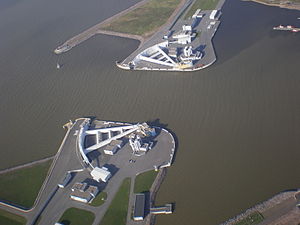

| External videos | |
|---|---|
The Saint Petersburg Flood Prevention Facility Complex[1] (Russian: Ко́мплекс защи́тных сооруже́ний Санкт-Петербу́рга от наводне́ний, romanized: kómpleks zashchítnykh sooruzhéniy Sankt-Peterbúrga ot navodnéniy), unofficially the Saint Petersburg Dam, is a 25 km (16 mi) long complex of dams for flood control near Saint Petersburg, Russia. The dam extends from Lomonosov northward to Kotlin Island (and the city of Kronstadt), then turns east toward Cape Lisiy Nos near Sestroretsk.
The complex is intended to protect Saint Petersburg from storm surges by separating the Neva Bay from the rest of the Gulf of Finland. The dam's tunnel also serves as the final leg of the Saint Petersburg Ring Road. The northern and southern parts of the dam act like two giant bridges, providing access from the mainland to Kotlin Island and Kronstadt.
Historically, storm surges from the gulf have caused over 300 floods of varying severity within the city, some with devastating effects. The dam has the capability to protect the city from water rising up to 5 m (16 ft).[2] Its first use to hold back the incoming Baltic water into Neva Bay on 28 November 2011 resulted in a water rise of 1.3 meters above sea level (masl), below the flood level of 1.6 masl according to the Baltic system of coordinates.[3] This prevented what would have been the 309th flood in the recorded history of the city, saving some 1.3 billion roubles of projected damage.[4]
The construction of the flood prevention complex started in 1978 and became one of the longest construction projects in Russia. After a protracted halt in the 1990s and early 2000s, construction was resumed in 2005 due to the intervention of Russia's President Vladimir Putin, a native of Saint Petersburg. Putin finally inaugurated the finished complex in 2011,[2][5] when all the facilities at the southern part of the dam were completed, along with the 1.2 km (0.75 mi) long underwater roadway tunnel below the main southern lock, the longest undersea tunnel in Russia.[6]
Over 30 water purification installations are placed around the dam, part of a larger program to clean the water in the Neva Bay.[2]
- ^ Before 2003 when construction resumed after a 15-year pause, the dam was officially called the "Leningrad Flood Prevention Facility Complex"
- ^ a b c St. Petersburg gets protecting dam Archived 8 September 2012 at the Wayback Machine Voice of Russia
- ^ (in Russian) Мощнейший ураган и наводнение накрыли Петербург: вода угрожает городу (ВИДЕО), 28 November 2011, www.glavred.info/ Главред, accessed 4 October 2020, tr. The most powerful hurricane and flood covered Petersburg: water threatens the city (VIDEO), Glavred
- ^ Дирекция КЗС: Дамба предотвратила ущерб в 1,3 млрд рублей (in Russian) tr. Directorate of KZS: Dam prevented damage in 1.3 billion rubles 29 November 2011, www.fontanka.ru, accessed 4 October 2020,
- ^ Saint Petersburg Dam official site (in Russian)
- ^ Ship opening S-1 at spb-projects.ru (in Russian)